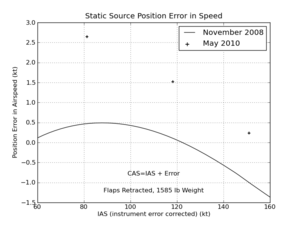Late Thursday afternoon I did a short flight to check static system errors and to gather some cruise performance data. I did a pretty complete flight test to measure static system errors in the early part of the flight test program, but there was a chance that they could have changed somewhat due to the new paint. Before the paint, I had vinyl registration letters with sharp stepped vinyl edges very close in front of the static ports. Now there is a roundel close to the static ports, but the edges are smoother. Also, there is now some thickness of paint on the skins, but the static ports (Van's recommended blind rivets with the stems pushed out) were masked off, so their surface is now a tiny bit closer to the fuselage surface than it was before.
 I checked the static system errors at 80, 120 and 150 kt, taking hand recorded data, and also recording data on my laptop. I crunched the hand recorded data, and all three points show errors one to two knots different than the original tests at the same speeds. I haven't crunched the data on the laptop yet, as I discovered that the recorded OAT data is screwed up. I had the engine monitor firmware updated while the aircraft was down for paint, and something has changed in the way the OAT data is handled. I need to sort that out before I can do much with the recorded data. But, it seems that the static system errors may possibly have changed a bit, so I'll plan to do another full set of flight tests to see what the full set of errors are now.
I checked the static system errors at 80, 120 and 150 kt, taking hand recorded data, and also recording data on my laptop. I crunched the hand recorded data, and all three points show errors one to two knots different than the original tests at the same speeds. I haven't crunched the data on the laptop yet, as I discovered that the recorded OAT data is screwed up. I had the engine monitor firmware updated while the aircraft was down for paint, and something has changed in the way the OAT data is handled. I need to sort that out before I can do much with the recorded data. But, it seems that the static system errors may possibly have changed a bit, so I'll plan to do another full set of flight tests to see what the full set of errors are now.
Note: Astute observers may notice that the November 2008 position error line shown on this graph is slightly different from the one that I originally posted in 2008. The original data crunching used an OAT probe recovery factor of 0.85, but as I gathered more data on later flights it became clear that the recovery factor was actually much less than that. It is hard to know the exact value, as there isn't enough resolution in the indicated OAT vs TAS data, but the average of all the data I have suggests it is on the order of 0.5. Changing the assumed value of the recovery factor changes the OAT values for any given indicated OAT, which changes the CAS that is calculated from the TAS, which in turn slightly changes the calculated airspeed error.